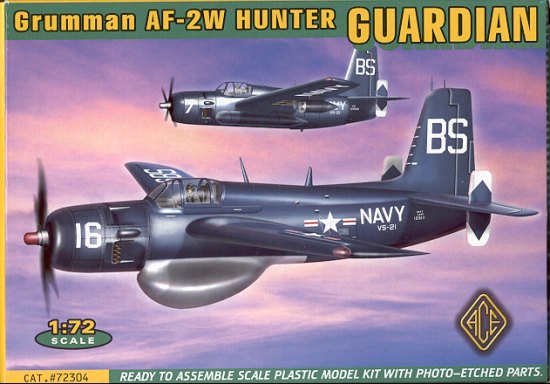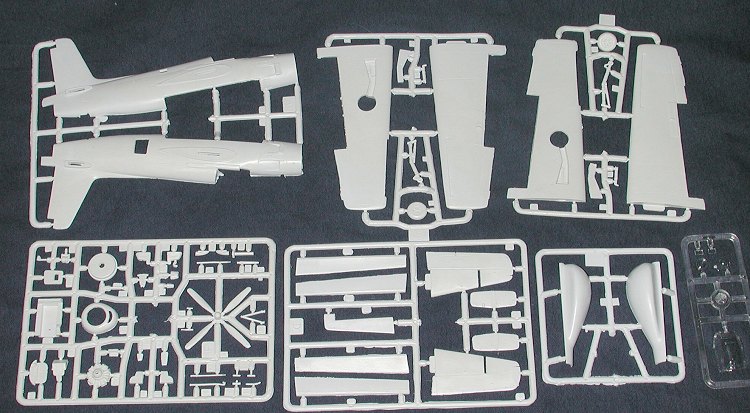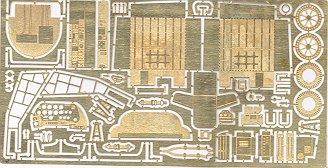
| KIT: | Ace 1/72 AF-2W Guardian |
| KIT #: | 72304 |
| PRICE: | $16.95 MSRP |
| DECALS: | Two options |
| REVIEWER: | Scott Van Aken |
| NOTES: | Short run with etched metal fret. |

| HISTORY |
The increased weight of the Avenger prompted the Navy and Grumman to look into designing a replacement. Work was well underway on the XTB2F (a twin engine design) when, in 1944, the Navy realized it would only be able to operate from its largest carriers and halted work. It then requested that the F7F be considered for modification to fit the torpedo bomber role.
Grumman then went to work on a totally new design for a new two-seat bomber in late 1944. After calculated performance figures indicated that this would be a viable replacement to the Avenger, a request for prototypes was made. This aircraft would be powered by a single R-3350 and a Westinghouse 24C turbo jet. Thanks to delays in both engine programs, stats for a lower performance R 2800 and 19C turbojet were then requested. Despite the lower performance, Grumman was requested to complete the three prototypes. With the availability of the R-3350 and W-24, Grumman was again requested to take the second prototype and fit it with this engine combination. Delivery delays kept pushing back the first flight date, until the first flight was finally made in December of 1946, but without the Westinghouse turbojet operating.
Thanks to the late date of things, the Navy already had much more promising aircraft to fit the XTB3F-1's roles; the Douglas AD-1 and Martin AM-1. Next in priority was something to replace the Avenger in the ASW Hunter-Killer roles and so Grumman was instructed to complete the second prototype as the XTB3F-2S attack version and the third prototype as the XTB3F-1S ASW search version. This required the removal of the turbojet to make space for three operators.
The mock-ups passed inspection and an order for 16 search and 14 attack aircraft was awarded in May 1948. The first prototype flew in November of 1948 and these planes were redesignated AF-2W for the radar plane and AF-2S for the attack or strike aircraft. Eventually 386 AF-2/3s were built with the type being replaced by the S2F-1 Tracker. The Guardian left Naval service by 1957 with the New York Reserves made the last flight. Several were modified as fire bombers and used by Aero Union of Chico, California until 1973. One of these was restored to AF-2S configuration and later donated to the Naval Air Museum in Pensacola.
| THE KIT |

Ace is apparently a reincarnation of Siga or they've swapped molds or something as this Ukraine kit looks very much like the AM-1 Mauler that Siga produced. That is to say, it is a low pressure mold short run kit. The dirty white plastic has engraved panel lines, rather thick plastic and some small amounts of flash on all the parts. The transparencies are also quite thick so any detail work in the cockpit will not be easily seen through it. Most of the thicker parts (like the small intake scoops and the prop hub) have sink areas that will need to be filled. Several of the larger parts (notably on sprue 'D') have what look like 'zits' of plastic on the surface that will need to be sanded off .
 Included with the kit is an
etched brass fret made of the thinnest brass I've ever seen with one of
these sets. Most of it is designed to enhance the cockpit, wheel wells and
gear struts. A separate rear crew entry door is provided, but there is
nothing in terms of a crew compartment to see through it. The kit can only
be built as an AF-2W as there is only the radome section to fit over the
open bomb bay.
Included with the kit is an
etched brass fret made of the thinnest brass I've ever seen with one of
these sets. Most of it is designed to enhance the cockpit, wheel wells and
gear struts. A separate rear crew entry door is provided, but there is
nothing in terms of a crew compartment to see through it. The kit can only
be built as an AF-2W as there is only the radome section to fit over the
open bomb bay.
Instructions are fairly well done with painting instructions provided in generic terms. There are markings provided for two aircraft, both in overall gloss sea blue. I can't show you the decals as they are basically white letters and numbers on a white backing! The aircraft are for VS-21 and VS-25. I seem to recall that the kit decals in the Mauler were only fair and expect the same on this one. Nice thing is that the little white geometric squadron designs on the finlets are easy to paint and the rest can easily be found in the various aftermarket letter/number sets should you decided to go that route.
| CONCLUSIONS |
Well, those of us who have wanted an AF-2 Guardian as an injected kit now have that option available to us. It probably will not be an easy build, but having this will surely please the US Navy fan and with careful building will provide a nice model for our shelves. I would be remiss if I didn't mention that this kit is also available as the strike version and as a fire bomber.
| REFERENCES |
Grumman Aircraft since 1929 by Rene J Francillon, 1989, Naval Institute Press ISBN 0-87021-246-X
Review kit courtesy of my luck at the raffle table!
If you would like your product reviewed fairly and quickly by a site that has over 250,000 visitors a month, please contact me or see other details in the Note to Contributors.